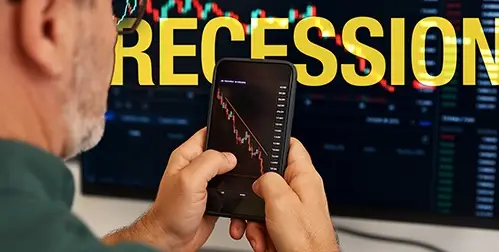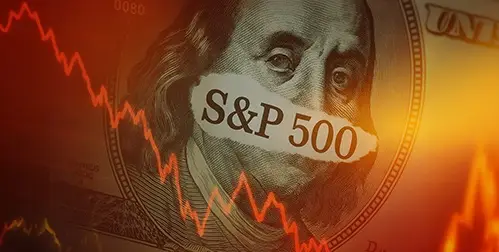- Billionaire investor Ray Dalio warns the U.S. is on the brink of a major economic downturn
- Rising debt, trade chaos, and global instability could trigger a crisis worse than a recession
- Protect your portfolio from uncertainty by investing in physical gold through a Gold IRA
Dalio Warns of Economic Crisis
Ray Dalio, founder of Bridgewater Associates and the man who famously predicted the 2008 financial crisis, is sounding a new alarm. In recent comments, Dalio warned that the U.S. is approaching a recession, and potentially something far worse.
“Right now we are at a decision-making point and very close to a recession,” Dalio said. “And I’m worried about something worse than a recession if this isn’t handled well.”1
Dalio’s concerns stem from several growing threats to the global economy. Threats such as rising national debt, disruptive trade policies, and a breakdown of long-standing political and economic systems. These forces, he warns, could converge into a crisis that may rival or even surpass the financial upheavals of 2008 or 1971, when the U.S. abandoned the gold standard.
A Ticking Time Bomb
At the heart of Dalio’s warning is the soaring U.S. debt, which now exceeds $36 trillion. He described the debt burden as a “ticking time bomb”. Dalio pointed to a fundamental “supply-demand problem for debt”. In other words, there’s too much debt and not enough buyers.

2
Congress, he says, must reduce the federal deficit to 3% of GDP to restore fiscal balance. But even that may not be enough to avoid economic turmoil.
Dalio also drew stark comparisons to the 1930s. He noted “profound changes” in both domestic and global orders. He said that the world is moving away from a multilateral order led by America. And it’s moving towards a more fragmented, conflict-driven unilateral one.
Disruptive Tariffs and Trade Uncertainty
Trade tensions are a major contributor to the instability. Tariffs aim to balance trade and bring production back home. But they are causing chaos in the global economy. Dalio likened the tariff policies to “throwing rocks into the production system.” He said that although the goals may be understandable, the implementation has been “very disruptive.”3
The White House has announced a 90-day pause on reciprocal tariffs. But they are maintaining a 10% baseline tariff and a 145% tariff on Chinese goods. Though some exemptions have been made for consumer electronics. With no clear end in sight, these rapidly shifting policies have upended international trade. There is “tremendous uncertainty” about which tariffs will remain in place and for how long.
The administration says that the main aim of these policies is to restructure global trade. But Dalio fears they might trigger instability on a scale not seen in decades. “How that’s handled could produce something that is much worse than a recession,” he warned.4
A Breakdown of Monetary and Political Order
Dalio’s warnings go beyond trade. “The far bigger, far more important thing to keep in mind is that we are seeing a classic breakdown of the major monetary, political, and geopolitical orders,” he said. “This sort of breakdown occurs only about once in a lifetime, but they have happened many times in history when similar unsustainable conditions were in place.”5
In his worst-case scenario, a financial and trade crisis could even escalate into a military conflict. “It’s going to be very severe,” he concluded.

Why Dalio Holds Gold
In the face of these dire predictions, Dalio uses gold as a hedge against risk.
“History and logic demonstrate that when there are substantial risks that debts will either default or be repaid with depreciated currency, both the debt and the currency become unappealing,” Dalio explained. “Gold, conversely, is a non-debt-backed form of money.”
He adds that gold is “like cash, except unlike cash and bonds, which are devalued by the risks of default or inflation, gold is bolstered by the risks of debt defaults and inflation.”6
As governments around the world attempt to manage their debt by printing more money, currencies risk losing value. This process, known as inflating the debt away, often leads to hyperinflation, another reason gold can serve as a safe haven.
Dalio describes gold as “money that I can go from one place to another with. And it’s accepted around the world; it’s accepted by central banks. Today, by the way, gold is the third-largest reserve after dollars and euros… it’s an asset that is not somebody else’s liability.”7
He also notes that gold typically has a negative correlation to traditional portfolios. Meaning it tends to rise when other assets fall. “If you were to say, what if I was to overlay gold in my portfolio, it would reduce the risk and increase the expected return.”
Conclusion
If you’re concerned about inflation, debt, and the possibility of a crisis worse than a recession, you’re not alone. Ray Dalio has studied history and sees troubling patterns repeating. He’s protecting his assets with gold, and you can do the same.
At American Hartford Gold, we help individuals protect their savings with physical gold held in a Gold IRA. You can take control of your financial future—call us today at 800-462-0071 to learn how.
















 3
3
